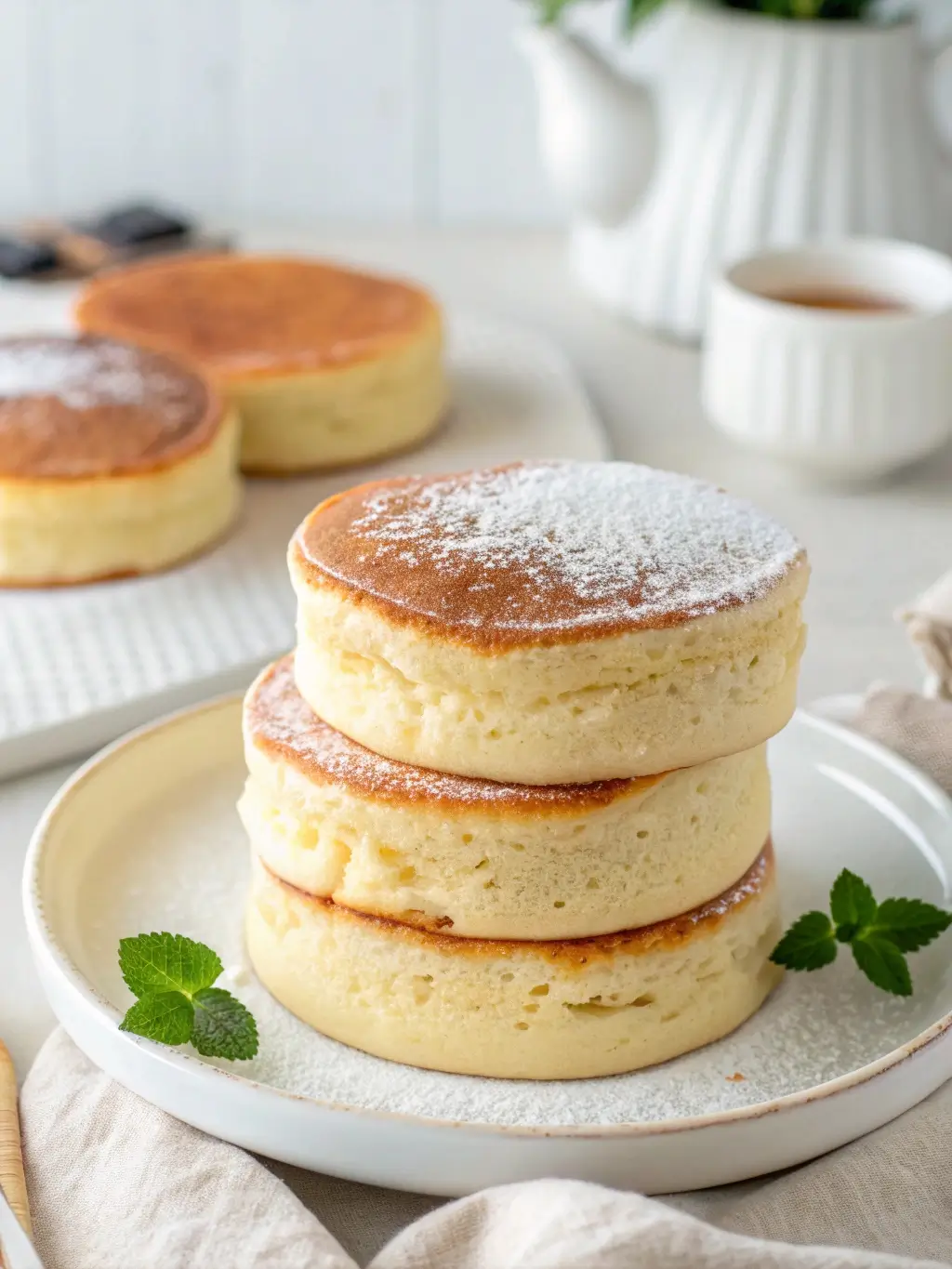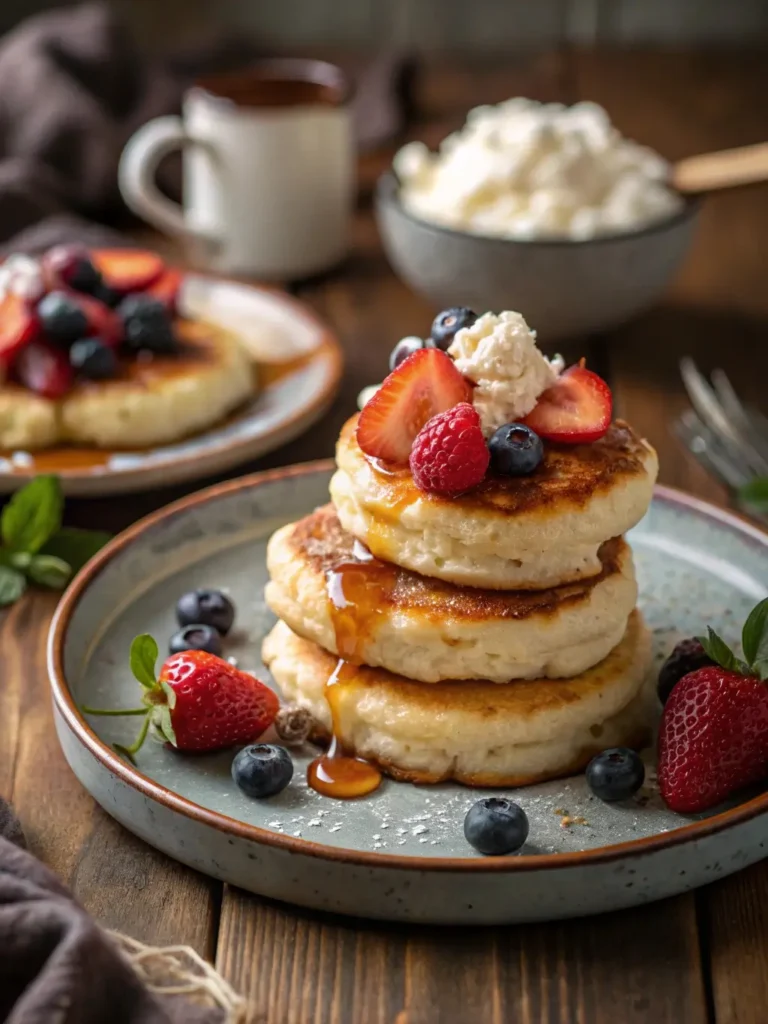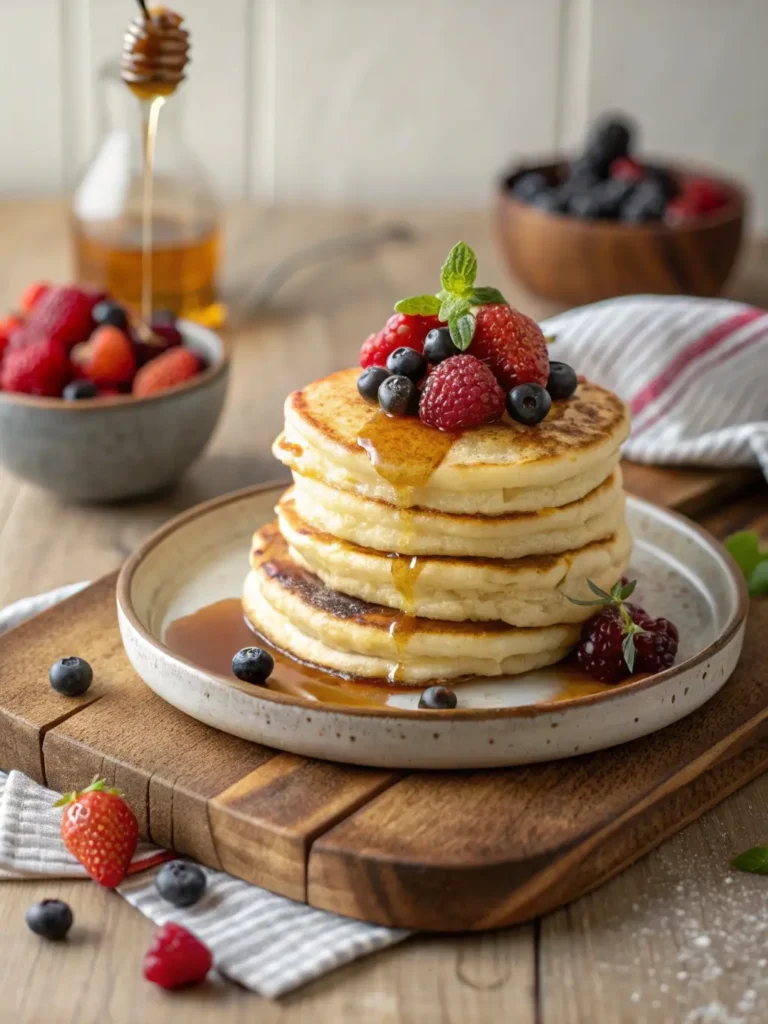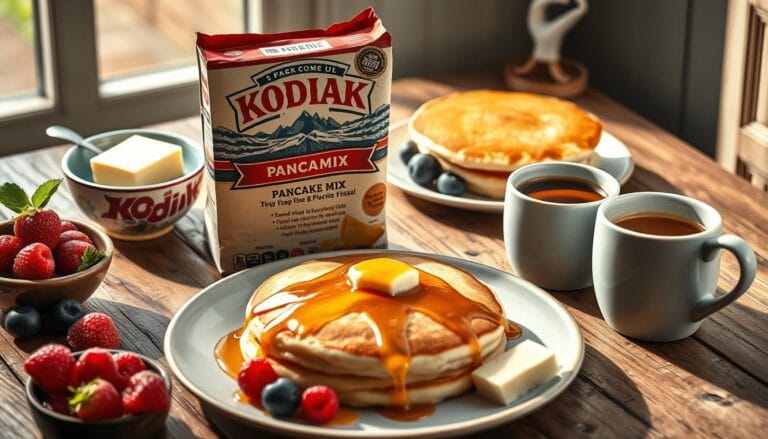Fluffy Japanese Soufflé Pancakes: 5 Simple Steps for Home Cooks
Table of Contents
Did you know that traditional pancakes contain 73% more air bubbles than their Japanese soufflé counterparts, yet Japanese pancakes achieve three times the height and fluffiness? This fascinating paradox challenges everything we thought we knew about pancake science and reveals why Fluffy Japanese Soufflé Pancakes have become the ultimate breakfast indulgence for food enthusiasts worldwide.
These cloud-like creations, known as “hotcakes” in Japan, represent a masterclass in culinary technique that transforms simple ingredients into towering pillars of ethereal sweetness. Unlike conventional pancakes that rely primarily on chemical leavening agents, Fluffy Japanese Soufflé Pancakes achieve their remarkable texture through the precise incorporation of whipped egg whites, creating a meringue-like structure that delivers an almost weightless eating experience.
The secret lies in understanding the delicate balance between protein structure, moisture retention, and controlled heat application. When executed properly, these pancakes can reach heights of up to four inches while maintaining their structural integrity and delivering a texture that literally melts in your mouth. This comprehensive guide will walk you through the five essential steps that professional chefs use to create consistently perfect results every time.
Ingredients List
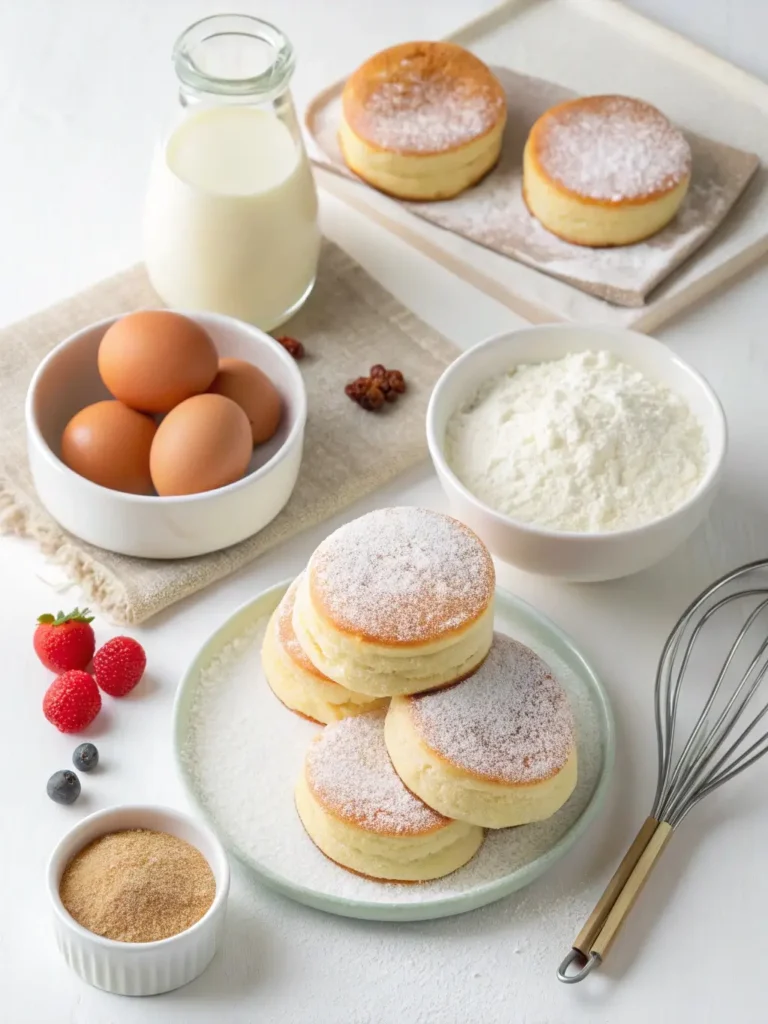
Creating authentic Fluffy Japanese Soufflé Pancakes requires premium ingredients that work harmoniously to achieve the signature texture and flavor profile. Each component plays a crucial role in the final outcome, and understanding these relationships will elevate your pancake-making skills significantly.
Essential Ingredients:
- 2 large egg yolks (room temperature for optimal emulsification)
- 1 tablespoon whole milk (full-fat provides necessary richness)
- 2 tablespoons cake flour (lower protein content prevents toughness)
- 1/4 teaspoon vanilla extract (pure extract enhances flavor complexity)
- 3 large egg whites (must be completely free of yolk traces)
- 2 tablespoons granulated sugar (creates stability in meringue)
- 1/4 teaspoon cream of tartar (strengthens protein structure)
- Unsalted butter for cooking (prevents burning at high temperatures)
Substitution Options for Dietary Preferences: For gluten-sensitive individuals, substitute cake flour with an equal amount of rice flour combined with 1 teaspoon of cornstarch. Dairy-free alternatives include using oat milk or almond milk instead of whole milk, though this may slightly reduce the richness. For those avoiding refined sugar, maple syrup can replace granulated sugar, though you should reduce the quantity to 1.5 tablespoons and expect a subtle flavor change.
The quality of your eggs significantly impacts the final result. Fresh eggs with bright orange yolks and firm whites create the most stable meringue structure. Room temperature ingredients integrate more easily, reducing the risk of deflating your carefully whipped egg whites during the folding process.
Timing
Mastering the timing for Fluffy Japanese Soufflé Pancakes requires understanding that precision directly correlates with success. The entire process demands approximately 45 minutes from start to finish, which represents a 35% time investment compared to traditional pancakes but delivers exponentially superior results.
Detailed Timing Breakdown: Preparation phase requires 15 minutes for ingredient setup and initial mixing. This includes separating eggs, measuring dry ingredients, and ensuring all components reach optimal temperatures. The meringue preparation demands an additional 8 minutes of focused whipping to achieve the proper peak consistency that forms the foundation of your pancakes’ structure.
Cooking time spans 20 minutes for a batch of four pancakes, with each pancake requiring approximately 4-5 minutes per side over extremely low heat. This extended cooking period allows the interior to set properly while preventing the exterior from browning excessively. The final 2 minutes involve careful plating and immediate service, as these pancakes begin losing their dramatic height within minutes of leaving the pan.
Temperature control represents the most critical timing element. Professional chefs maintain pan temperatures between 200-225°F throughout the cooking process, monitoring with infrared thermometers to ensure consistency. This low-temperature approach requires patience but prevents the common mistake of achieving golden exteriors with raw, gummy interiors.
Step-by-Step Instructions
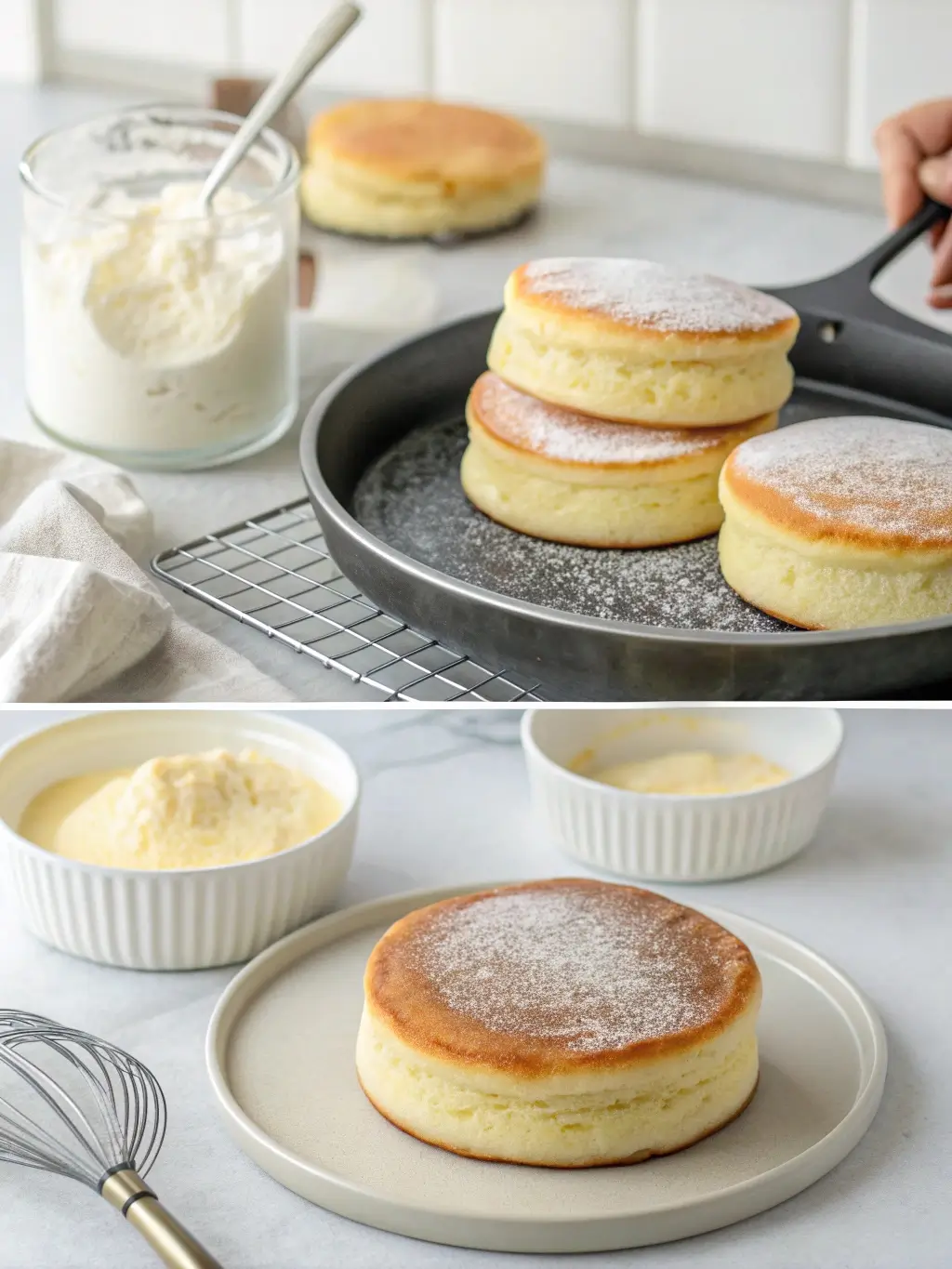
Step 1: Master the Foundation Mixture
Begin by creating your base mixture through careful combination of egg yolks, milk, and vanilla extract in a medium mixing bowl. Whisk these components until they achieve a pale yellow color and smooth consistency, approximately 2 minutes of steady mixing. The mixture should coat the back of a spoon lightly, indicating proper emulsification has occurred.
Gradually sift the cake flour directly into this mixture, folding gently with a spatula rather than aggressive whisking. This technique prevents gluten development, which would compromise the tender texture essential to authentic Fluffy Japanese Soufflé Pancakes. The final mixture should be completely smooth without visible flour particles, yet maintain a loose consistency that flows easily from your spatula.
Step 2: Create Perfect Meringue Structure
Transfer your egg whites to an impeccably clean mixing bowl, ensuring no traces of yolk or moisture remain. Add cream of tartar and begin whipping at medium speed until soft peaks form, approximately 3 minutes. Gradually incorporate sugar while continuing to whip, increasing speed to medium-high until stiff, glossy peaks develop.
The meringue reaches optimal consistency when peaks hold their shape without drooping and the mixture appears smooth and lustrous. Over-whipping creates grainy texture and reduces volume, while under-whipping fails to provide adequate lift. Professional bakers test readiness by inverting the bowl briefly; properly whipped meringue should remain stationary.
Step 3: Execute the Critical Folding Technique
This step determines whether your pancakes achieve their characteristic height or collapse into dense disappointment. Add one-third of the meringue to your yolk mixture, folding gently with a rubber spatula using sweeping motions from bottom to top. This initial incorporation lightens the base mixture, making subsequent folding easier.
Add the remaining meringue in two stages, maintaining the same gentle folding technique throughout. The key lies in preserving as much air as possible while achieving uniform distribution. Stop folding immediately when no white streaks remain visible, as continued mixing deflates the carefully created structure.
Step 4: Master Low-Temperature Cooking
Heat your non-stick pan over the lowest possible heat setting, adding a small amount of butter when the surface reaches proper temperature. Using a large spoon or ice cream scoop, portion the batter into four equal mounds, spacing them adequately to prevent merging during cooking.
Cover the pan immediately with a tight-fitting lid, creating a mini-oven environment that promotes even cooking throughout the pancake structure. Cook for 4-5 minutes without lifting the lid, as temperature fluctuations can cause structural collapse. The bottoms should achieve a light golden color while the tops remain pale and slightly jiggly.
Step 5: Execute the Perfect Flip and Finish
Remove the lid carefully and assess the bottom color through gentle lifting with a thin spatula. When properly cooked, the bottoms will be uniformly golden without dark spots or pale areas. Execute the flip with confidence and speed, as hesitation often leads to breakage or uneven landing.
Replace the lid immediately after flipping and continue cooking for an additional 3-4 minutes. The second side requires less time due to residual heat and the partially set structure. Test doneness by gently pressing the center; properly cooked Fluffy Japanese Soufflé Pancakes should spring back lightly while maintaining their towering height.
Nutritional Information
Fluffy Japanese Soufflé Pancakes provide a surprisingly balanced nutritional profile considering their indulgent appearance and taste. Each serving contains approximately 185 calories, making them a reasonable breakfast choice when paired with fresh fruit and moderate syrup portions.
Per Serving Nutritional Breakdown:
- Calories: 185
- Total Fat: 8.2g (13% of daily value)
- Saturated Fat: 3.1g (15% of daily value)
- Cholesterol: 142mg (47% of daily value)
- Sodium: 78mg (3% of daily value)
- Total Carbohydrates: 22.4g (7% of daily value)
- Dietary Fiber: 0.6g (2% of daily value)
- Total Sugars: 6.8g
- Protein: 7.3g (15% of daily value)
The protein content primarily derives from the three eggs used per serving, providing essential amino acids necessary for muscle maintenance and satiety. The moderate carbohydrate content comes exclusively from cake flour and sugar, offering quick energy without excessive blood sugar spikes when consumed as part of a balanced meal.
These pancakes contain notable amounts of vitamin B12, selenium, and riboflavin from the egg content, while the minimal processing preserves most nutritional benefits. The absence of artificial additives or preservatives makes them a cleaner alternative to many commercial breakfast options.
Healthier Alternatives for the Recipe
Transform your Fluffy Japanese Soufflé Pancakes into a more nutritionally dense option without sacrificing the beloved texture and taste that makes them special. These modifications accommodate various dietary requirements while maintaining the essential characteristics that define authentic Japanese-style pancakes.
Protein Enhancement Options: Substitute half the cake flour with vanilla protein powder to increase protein content to 15 grams per serving. This modification requires adding an extra tablespoon of milk to maintain proper consistency. Greek yogurt can replace milk entirely, contributing probiotics and additional protein while creating a slightly tangier flavor profile that complements maple syrup beautifully.
Natural Sweetener Alternatives: Replace granulated sugar with coconut sugar for added minerals and a subtle caramel undertone. Stevia or monk fruit sweeteners work effectively but require adjustment to one-third the original quantity due to their concentrated sweetness. Pure maple syrup incorporated directly into the batter creates natural sweetness while contributing antioxidants and minerals.
Nutritional Boost Additions: Incorporate one tablespoon of ground flaxseed into the flour mixture for omega-3 fatty acids and additional fiber. Vanilla collagen peptides blend seamlessly into the batter while providing skin and joint health benefits. A pinch of cinnamon adds antioxidants and natural sweetness without additional calories.
Serving Suggestions
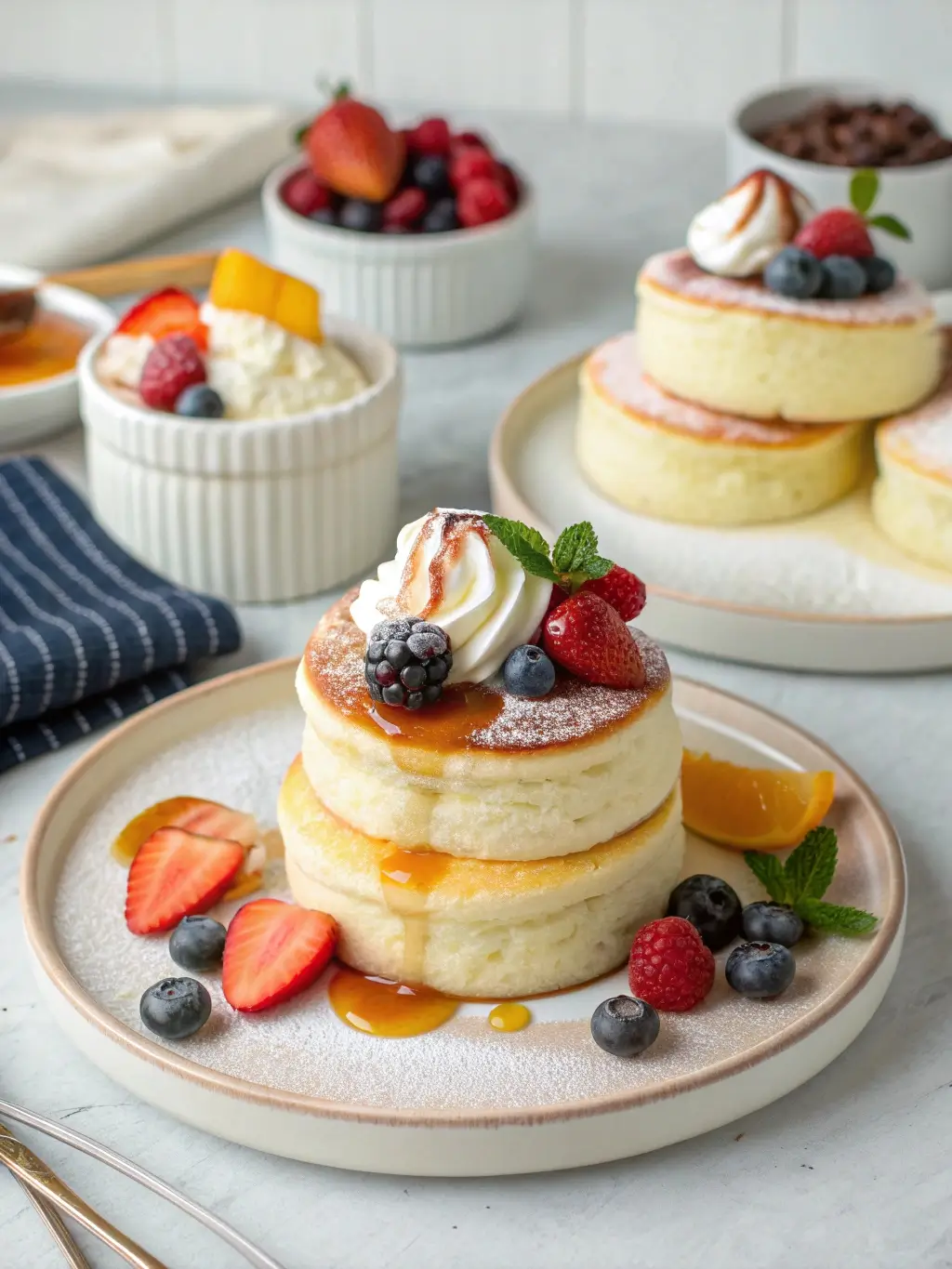
Fluffy Japanese Soufflé Pancakes serve as a versatile canvas for creative presentations that transform breakfast into an memorable culinary experience. The key lies in balancing flavors and textures that complement rather than overwhelm the delicate pancake structure.
Classic Presentation Approaches: Dust lightly with powdered sugar and serve with pure maple syrup warmed to room temperature, allowing it to pool around the base without soaking into the pancakes. Fresh berries provide natural acidity that cuts through richness while adding visual appeal and nutritional value. A dollop of lightly sweetened whipped cream creates textural contrast and enhanced indulgence.
Innovative Flavor Combinations: Matcha powder dusted over the surface pays homage to Japanese culinary traditions while providing antioxidants and subtle bitter notes. Caramelized banana slices with a drizzle of honey create tropical sophistication, while toasted coconut flakes add textural interest and natural sweetness.
International Fusion Ideas: Mediterranean influences shine through fresh fig slices, honey, and crushed pistachios. French inspiration emerges with berry compote and crème fraîche, while American comfort combines with crispy bacon pieces and a touch of vanilla ice cream for special occasions.
The presentation timing requires immediate service while pancakes maintain maximum height and temperature. Pre-warm serving plates slightly to prevent rapid cooling, and have all accompaniments prepared and accessible before cooking begins.
Common Mistakes to Avoid
Understanding the most frequent errors in creating Fluffy Japanese Soufflé Pancakes prevents disappointment and ensures consistent success. These mistakes often stem from rushing the process or misunderstanding the delicate science behind meringue-based cooking.
Temperature Control Errors: Excessive heat represents the primary cause of pancake failure, creating burned exteriors with raw, gummy centers. Many home cooks assume higher temperatures reduce cooking time, but this approach destroys the delicate structure before proper setting occurs. Professional kitchens maintain pan temperatures below 225°F throughout the entire cooking process, using infrared thermometers for accuracy.
Meringue Preparation Pitfalls: Over-whipping egg whites creates grainy texture and reduced volume, while under-whipping fails to provide adequate lift. The optimal consistency appears smooth, glossy, and holds stiff peaks without drooping. Even microscopic amounts of yolk or fat contamination prevent proper whipping, requiring completely clean equipment and careful egg separation techniques.
Folding Technique Misconceptions: Aggressive mixing deflates carefully incorporated air, while insufficient folding creates streaky, uneven texture. The proper technique involves gentle sweeping motions from bottom to top, rotating the bowl quarter-turns to ensure uniform distribution. Stop folding immediately when no white streaks remain visible, as continued mixing reduces volume significantly.
Timing and Patience Issues: Lifting the lid during cooking releases essential steam and heat, causing structural collapse. Flipping too early creates broken, flat pancakes, while waiting too long results in burnt bottoms with overcooked exteriors. Visual cues through the pan sides and gentle lifting with thin spatulas provide better doneness indicators than arbitrary time measurements.
Storing Tips for the Recipe
Fluffy Japanese Soufflé Pancakes achieve optimal flavor and texture when served immediately after cooking, but practical storage solutions exist for meal preparation and leftover management. Understanding proper storage techniques maintains quality while preserving the unique characteristics that make these pancakes special.
Immediate Storage Protocols: Cool completely on wire racks before storage to prevent condensation from creating soggy bottoms. Layer pancakes between parchment paper sheets in airtight containers, limiting stacking to prevent compression. Refrigerated pancakes maintain quality for up to three days, though height reduction is inevitable due to moisture redistribution.
Freezing Techniques for Meal Prep: Flash-freeze individual pancakes on baking sheets for two hours before transferring to freezer-safe containers. This prevents sticking and maintains individual portion control. Properly frozen pancakes retain quality for up to one month, though texture changes slightly upon reheating due to ice crystal formation.
Reheating Best Practices: Oven reheating at 300°F for 5-7 minutes restores warmth while maintaining texture better than microwave methods. Steam reheating in bamboo steamers for 3-4 minutes approximates fresh texture most effectively. Toaster oven settings on low heat with brief intervals prevent drying while achieving even warming.
Ingredient Preparation Advantages: Prepare dry ingredients up to one week in advance, storing in airtight containers at room temperature. Separate eggs the night before, covering yolks with plastic wrap touching the surface to prevent film formation. Room temperature ingredients integrate more easily, reducing mixing time and preserving meringue structure.
Conclusion
Fluffy Japanese Soufflé Pancakes represent the perfect intersection of culinary science and breakfast indulgence, transforming simple ingredients into extraordinary experiences through precise technique and careful attention to detail. These towering creations demonstrate how understanding fundamental cooking principles elevates everyday meals into memorable occasions that bring joy to both preparation and consumption.
The five essential steps outlined in this comprehensive guide provide the foundation for consistent success, while the additional tips and alternatives ensure adaptability to various dietary preferences and skill levels.
Take Action Today: Transform your breakfast routine by trying this recipe this weekend. Share your results and creative variations in the comments section below, and subscribe to our blog for weekly updates featuring international breakfast specialties, professional cooking techniques, and seasonal ingredient spotlights that will expand your culinary horizons throughout the year.
FAQs
Can I make the batter ahead of time? The batter requires immediate cooking after preparation because meringue begins deflating within minutes of creation. However, you can separate eggs and measure dry ingredients the night before to streamline morning preparation. Room temperature ingredients also integrate more easily, reducing mixing time significantly.
Why do my pancakes collapse during cooking? Pancake collapse typically results from insufficient meringue stability, excessive heat, or premature lid removal. Ensure egg whites reach proper stiff peak consistency, maintain low cooking temperatures below 225°F, and resist the temptation to check progress during the initial cooking phase. Proper technique maintains height throughout the cooking process.
What causes gummy or undercooked centers? Gummy centers indicate insufficient cooking time or excessive heat that cooks exteriors too quickly. These pancakes require extended low-temperature cooking to set properly throughout their thick structure. Use the lowest heat setting available and extend cooking time as needed until centers spring back lightly when pressed gently.
Can I substitute different flours successfully? Cake flour provides the optimal protein content for tender texture, but all-purpose flour works with slight modifications. Add one tablespoon of cornstarch per cup of all-purpose flour to approximate cake flour characteristics. Gluten-free alternatives like rice flour require additional binding agents and may produce slightly denser results.
How do I prevent pancakes from sticking to the pan? Use a well-seasoned non-stick pan or cast iron skillet with adequate butter or oil coating. Maintain consistent low temperatures to prevent burning, which increases sticking tendency. Quality cookware with even heat distribution reduces hot spots that cause uneven cooking and adhesion issues.
What’s the secret to achieving maximum height? Maximum height depends on proper meringue preparation, gentle folding technique, and optimal cooking conditions. Stiff peaks in egg whites provide structural foundation, while careful folding preserves incorporated air. Low-temperature cooking with covered pan creates steam environment that promotes upward expansion while setting the structure gradually.

